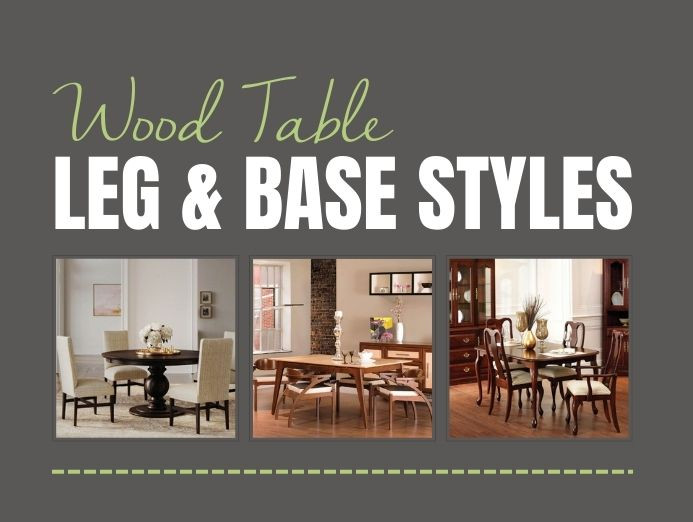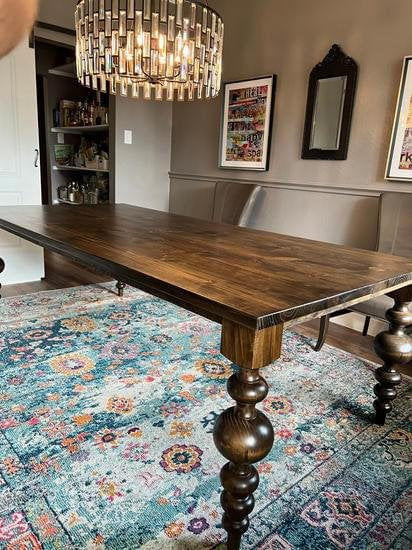Exactly How to Pick the Perfect Dining-room Table Legs for Your Home Decor
Selecting the suitable dining-room table legs is a nuanced process that needs mindful consideration of various aspects, including your room restraints, aesthetic preferences, and useful requirements. The interaction in between materials, measurements, and styles can significantly influence the setting of your dining area, making it vital to approach this choice systematically. As you consider the myriad alternatives readily available, it comes to be clear that the appropriate choice extends beyond mere appearance; it can boost your general eating experience. What aspects should you prioritize to ensure your selection complements your home's unique character?
Assess Your Eating Room
Examining your dining room is vital for selecting the right table legs that enhance both appearances and performance. Begin by measuring the measurements of your dining area, consisting of ceiling height, flooring room, and distance to other furniture. This info will assist identify the ideal size and elevation of your eating table, which straight influences the selection of table legs.
Following, take into consideration the style and design of your dining space. As an example, an open-concept design may gain from table legs that use visual lightness, such as slim metal or acrylic options. On the other hand, an extra typical setup could ask for durable wooden legs that supply a feeling of permanence.
Examine the existing color combination and materials in your dining area. Integrating the table legs with these aspects produces a cohesive look that enhances the overall design.
Ultimately, a complete evaluation of your dining area will lead you in making an informed choice, making certain that your table legs not just improve the visual allure yet additionally offer sensible functions.
Consider Your Style Preferences
When choosing eating area table legs, it is important to reflect on your personal style choices, as they significantly affect the total visual of your dining space. Your selection of table legs can either complement or comparison with existing decor, making it crucial to align them with your favored interior decoration style.
If your home leans towards a modern-day aesthetic, consider streamlined metal or minimal wooden legs that provide a tidy, uncluttered appearance. For a much more traditional strategy, elaborate wood legs with elaborate carvings can add a touch of elegance and refinement. Industrial styles gain from durable, raw materials such as recovered wood and steel combinations, showing a tough beauty.
In addition, farmhouse and rustic designs commonly prefer strong, chunky legs that stimulate a sense of heat and comfort. Conversely, if your decoration is eclectic, you could select non-traditional forms or a mix of materials to develop visual rate of interest.

Evaluate Product Options
The selection of material for dining room table legs plays a pivotal role in both sturdiness and aesthetic charm. Typical products consist of timber, steel, and composite alternatives, each offering unique characteristics that can affect the general appearance and long life of your table.
Timber is a timeless choice, known for its warmth and flexibility. Hardwoods like oak and walnut offer outstanding toughness and can be ended up in different spots to match any type of decoration. Nonetheless, softwoods like ache are extra vulnerable to damages and scrapes, making them much less suitable for high-traffic locations.
Metal legs, commonly crafted from steel or light weight aluminum, exude modernity and industrial appeal. They are resistant and highly sturdy to put on, making them ideal for family members with youngsters or regular events (dining room table legs). Additionally, metal can be ended up in numerous colors, boosting the modification possibilities
Composite materials, such as MDF or laminate, offer affordability and diverse layouts. While commonly less sturdy than strong wood or metal, they can still provide a fashionable look and are usually very easy to maintain.
Ultimately, the material you choose need to line up with your lifestyle, visual preferences, and the degree of use your table will certainly experience.
Determine Height and Dimension
Picking the proper height and dimension for your dining-room table is necessary for both performance and comfort. The common height for dining tables generally varies from 28 to 30 inches, enabling ample legroom for most people when seated. However, it is important to take into consideration the measurements of your dining area and the kinds of chairs you intend to use.

Additionally, think about the percentages of your dining-room. A larger table in a roomy location can produce read this post here a grand atmosphere, while a smaller table functions well in even more intimate settings. Inevitably, the ideal height and dimension will balance with your overall decor and boost the eating experience for you and your visitors.
Explore Personalization Opportunities

Additionally, the layout of the legs can be personalized to fit numerous styles, such as rustic, modern, or industrial. For instance, tapered legs can evoke a mid-century contemporary feel, while beefy, block-style legs might reverberate with conventional or farmhouse design.
Home owners can additionally check out shade coatings, from natural wood discolorations to repaint, enabling them to match or contrast with the tabletop and bordering design.
In addition, leg elevation can be adapted to suit specific seating arrangements or individual preferences, enhancing both convenience and performance.
Lastly, one-of-a-kind embellishments, such as carvings or attractive braces, can additionally customize the table legs, making the dining experience not simply navigate to this website a meal but a statement item in the home. By considering these customization choices, homeowners can develop a dining room table that truly shows their originality.
Final Thought
Picking the ideal dining-room table legs needs mindful consideration of different aspects, consisting of the dimensions of the eating space, design choices, product toughness, and wanted elevation. Customization choices better enhance the capacity to attain a cohesive aesthetic that matches the general design. By methodically assessing these components, property owners can ensure that the chosen table legs not just accomplish useful demands yet also add favorably to the dining experience and atmosphere of the home.
Selecting the optimal eating room table legs is a nuanced procedure that requires mindful consideration of numerous aspects, including view your area restraints, visual preferences, and functional demands.Analyzing your eating room is important for picking the right table legs that complement both appearances and performance.When identifying size, measure the area where the table will certainly be positioned to guarantee it fits pleasantly, permitting for at the very least 36 inches of clearance around the table for simple activity. A larger table in a spacious location can produce a grand ambiance, while a smaller sized table works well in more intimate setups.Selecting the optimal dining area table legs requires mindful consideration of various factors, consisting of the dimensions of the dining room, style preferences, product longevity, and wanted elevation.